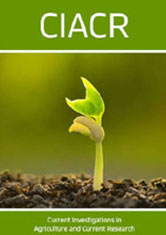-
Research ArticleView abstract
 PDF
PDF
 Full text
Oyster mushroom is a white fungus that uses lignin and cellulose found in most agro-wastes as its carbon source. A study was conducted at the University of Malawi to evaluate the efficiency of different substrates used for cultivating oyster mushroom namely banana leaves, maize stalks, beans pods, rice straw, ground nut shells, pea pods and bamboo leaves. The steps involved in preparation of spawn was collection and preparation of substrates, spawning of the substrates and incubation, management in the fruiting house, and harvesting...... ReadMore
Full text
Oyster mushroom is a white fungus that uses lignin and cellulose found in most agro-wastes as its carbon source. A study was conducted at the University of Malawi to evaluate the efficiency of different substrates used for cultivating oyster mushroom namely banana leaves, maize stalks, beans pods, rice straw, ground nut shells, pea pods and bamboo leaves. The steps involved in preparation of spawn was collection and preparation of substrates, spawning of the substrates and incubation, management in the fruiting house, and harvesting...... ReadMore -
Research ArticleView abstract
 PDF
PDF
 Full text
Improving phosphorus (P) use efficiency of indica rice is a major concern of rice breeders. Promising rice genotypes and potential genes contributing phosphorus use efficiency (PUE) in indica rice were identified using marker assisted selection and bulk expression profiling. Segregating population (F3) derived from Sahbhagi Dhan and RRF-78 was evaluated for root traits and yield attributing factors under P-supplemented and P-deficient conditions...... ReadMore
Full text
Improving phosphorus (P) use efficiency of indica rice is a major concern of rice breeders. Promising rice genotypes and potential genes contributing phosphorus use efficiency (PUE) in indica rice were identified using marker assisted selection and bulk expression profiling. Segregating population (F3) derived from Sahbhagi Dhan and RRF-78 was evaluated for root traits and yield attributing factors under P-supplemented and P-deficient conditions...... ReadMore -
Research ArticleView abstract
 PDF
PDF
 Full text
The use of forest reserves as a carbon sink triggered afforestation programs as urban settlements around the world were characterized by poor air quality, especially greenhouse gas pollution. In this research, the tolerance of germination of Moringa oleifera, Jatropha curcas, and Albizia lebbeck to atmospheric greenhouse gas was evaluated...... ReadMore
Full text
The use of forest reserves as a carbon sink triggered afforestation programs as urban settlements around the world were characterized by poor air quality, especially greenhouse gas pollution. In this research, the tolerance of germination of Moringa oleifera, Jatropha curcas, and Albizia lebbeck to atmospheric greenhouse gas was evaluated...... ReadMore -
Research ArticleView abstract
 PDF
PDF
 Full text
The traditional excellent agricultural culture contains many excellent ideological concepts, humanistic spirit, and moral norms. Integrating these ideological concepts and humanistic spirit into ideological and political education in universities can not only help revitalize rural culture, but also enhance students’ comprehensive quality and enrich the content of ideological and political education...... ReadMore
Full text
The traditional excellent agricultural culture contains many excellent ideological concepts, humanistic spirit, and moral norms. Integrating these ideological concepts and humanistic spirit into ideological and political education in universities can not only help revitalize rural culture, but also enhance students’ comprehensive quality and enrich the content of ideological and political education...... ReadMore -
OpinionView abstract
 PDF
PDF
 Full text
At the original Agriculture stage, the population is smaller. People live on picking up wild fruit and the rate of resources use level is low. The point of original Agriculture stage into the yield and quality increasing stage is the domestication of wild plant for high yield and better quality...... ReadMore
Full text
At the original Agriculture stage, the population is smaller. People live on picking up wild fruit and the rate of resources use level is low. The point of original Agriculture stage into the yield and quality increasing stage is the domestication of wild plant for high yield and better quality...... ReadMore -
Research ArticleView abstract
 PDF
PDF
 Full text
The study aimed to determine the attitudes of consumers, their level of the information and the classification factors that influence towards the safety of agricultural products (Vegetables and Fruits) at the purchasing decision through a case study of workers at the Agricultural Scientific Research Center in the Swaida Governorate/Syria during 2021-2022...... ReadMore
Full text
The study aimed to determine the attitudes of consumers, their level of the information and the classification factors that influence towards the safety of agricultural products (Vegetables and Fruits) at the purchasing decision through a case study of workers at the Agricultural Scientific Research Center in the Swaida Governorate/Syria during 2021-2022...... ReadMore -
Research ArticleView abstract
 PDF
PDF
 Full text
This study conducted at the University of Oyo Teaching and Research Farm and Research and Teaching Farm University of Agriculture Makurdi, 2019. The aim of the experiment is to examine the effectiveness of variety and weeding regimes on growth and yield components of cassava. It is a factorial experimental design with two factors, four varieties (TMS 30555, TMS419, NR8083 and NR8208) and four weeding regime...... ReadMore
Full text
This study conducted at the University of Oyo Teaching and Research Farm and Research and Teaching Farm University of Agriculture Makurdi, 2019. The aim of the experiment is to examine the effectiveness of variety and weeding regimes on growth and yield components of cassava. It is a factorial experimental design with two factors, four varieties (TMS 30555, TMS419, NR8083 and NR8208) and four weeding regime...... ReadMore -
Research ArticleView abstract
 PDF
PDF
 Full text
Feed consumed by animal is subject to natural processes in the animal system before it could be useful to the animal. And it is after digestion that the imbedded nutrients can be available for use by animal for various purposes. Non-conventional foodstuff could be fed to animal..... ReadMore
Full text
Feed consumed by animal is subject to natural processes in the animal system before it could be useful to the animal. And it is after digestion that the imbedded nutrients can be available for use by animal for various purposes. Non-conventional foodstuff could be fed to animal..... ReadMore
Lupine Publishers Group
Lupine Publishers
ISSN: 2637-4676
Current Investigations in Agriculture and Current Research
Current Investigations in Agriculture and Current Research (CIACR) is an open access includes Agronomy and Crop Science, Animal Genetics, Animal Physiology, Animal Structure and Function, Animal Welfare, CAB (Centre for Animal Biotechnology), Equine Medicine and surgery, Farm Animal Medicine, food Science, Mackinnon, Microbiology, Epidemiology and Pathology, Plant Molecuar Biology and Biotechnology, Parasitological, Rural Innovation and Agricultural Economics, Small Animal Medicine and Surgery, Soil Science. This Journal consist of technological inventions in the field of agronomy, plant breeding, application of pesticides, fertilizers and other agrochemicals. The Main aim of this journal is to publish articles on new developments, concepts and directions is showcased in this journal to promote agricultural research internationally.



















.png)
.jpg)

